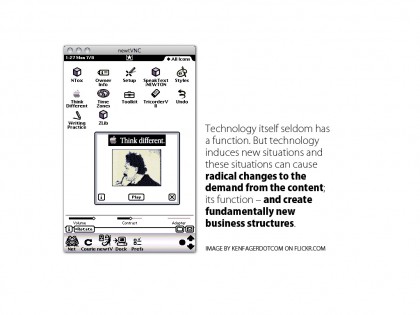In order to understand the future of news we need to stop focusing the product; the content and the distribution, and start thinking about the situation; where and how it is engaged and its function.
In my first presentation on media called Future Media, I focused on changes to the media business model (from products to value and from infrastructure to relationships)
. In this article I will try to present the second idea (of three). This one specifically on news content – which, because of its nature, presents its own opportunities
.

The two faced monster of news
- “The question is not what will happen to newspapers, but if we can save journalism”. – Clay Shirky
Why would this be true, and why is it over simplifying the role of media, journalism and the adoption of technology?
Journalists have been arguing for some years that the speed of online publishing is eating at the quality of their work. (Speed might be a constructed limitation; “speed is to the Internet what price is to retail”, and only one in 67 pages in this report include a reference to speed)
.
At the same time there is a huge debate on the quality itself of the Jorunalism-erati out there, especially after the run-up to the 2003 Iraq war.
A notion is that journalists used to have the upper hand, but media training and PR companies are getting so good at handling media that they are out smarting them ten to one. And as journalists faced with the difficult task of not having either the time or knowledge to challenge these peoples’ claims, they turn into distribution drones for messages the interviewees want to distribute to the public
.
No, this is not supposed to be a political argument, but it is the core of the problem, because when journalists turn in to content distributors – then everybody can do their job.
When Twitter was the first with the Hudson river images – it was just content, and people have their own content networks – faster, and better connected than the media publishing platforms. But there is a difference between content and news, and this is what we fail to see as we focus on speed and speed alone.
Do people want smarter news, rather than just distributed content? Do they want to spend more time with news? Do they want their existing assumptions challenged, do they want analysis and insights?
Yes they do, but we don’t see it, because we confuse news with news!
- In Norway people visit online newspapers 4-6 times a day, not because they are so hungry for the latest in political uproar – but because they want something fresh, they want a break from their routine and their brains want to be entertained. Online news is entertainment. And online newspapers is the best form of entertainment there is – it understands both the situation that people enjoying the content is in, and it understands the format requirements for fitting into this ‘quick break from daily chores routine’-culture. And it understands the function of the situation.
But people also want analysis, they want knowledge, and they want to learn, they even sometimes want their assumptions challenged. So they buy newspapers, they watch daily news shows on TV. They enjoy traditional news publications.
These are two completely different situations, with two completely different functions; the problem is that we have confused them with each other because, as opposed to the Eskimos’ that have 37 words for ‘snow’, we have only one word for ‘news’. We lack the articulation to discuss the difference between news as entertainment and news as information
• Grade as low, intermediate or high risk using simple criteria in Table V(about half cialis.
. And by that we fail to see that the stuff people eagerly consume online all through the day is something fundamentally different from the stuff that should be served in traditional publications – that people want to enjoy and spend time with.
These are of course just my assumptions, and the picture is a hundred times more nuanced than I present here, but assumptions that are trying to say that content is rich and diverse, and not because its on different technological platforms, but because we enjoy it in different situations. And people engage in different situations with different motivations and ambitions: each situation has it own function.
And we can see media understand this in its content – but not in its business models!
We are too focused on the abilities of the technological platforms that we ignore the situation where it is consumed, and we forget that technology itself seldom has a function. But technology induces new situations and these situations can cause radical changes to the demand from the content; its function – and create fundamentally new business structures.
So in my mind there are completely different business models here, for different kinds of situations. Where even the traditional news formats need to understand their “new” situations, and the value they are contributing to the function of it: TV is social, paper is personal, online is entertainment and so forth…


Very interesting reflections on a difficult challenge for those of us working in the news business.
I agree: News is not news – and a front page of a news site fullfill a different function than a newspaper.
But finding the best business models for the different situations is still as tough … :)
Hi John Einar
Glad you liked the article, and good to have an insiders take on the topic:
http://www.betatales.com/
It’s tough stuff, but Aftenposten.no is doing quite well, so a very interesting publisher to follow.
Best
Helge
In an ideal world, people would be able to use all these various tools to their intended benefit. In reality, I think they contribute to an overall distractibility, as seen in studies on the topic (eg recent Stanford one: http://news.stanford.edu/news/2009/august24/multitask-research-study-082409.html).
There is a sustained discipline required in reading books and longer pieces of journalism. This is not the case with Twitter and facebook and most blogs.
Hi Mike
Thanks again for your contribution to this blog.
I completely agree with you, and have myself lately been paying attention to what value I personally get from daily entertainment (reading inspirational blogs and twitter), compared to the slower, “dated” content of books.
And, I must say the felt return on investment is quite shocking. Spending two hours on a book, or four hours sweating over a blog post, far – far, outweighs the value I get from spending the equivalent amount of time wading through inspirational blogs and other “fast” resources (no matter how brilliant).
So, on the one side you got the Stanford research, saying that all this multitasking isn’t necessarily making us smarter, and on the other side – even if you’re able to divert your attention back and forth at the speed of light, how valuable is all this information?
Best
Helge
What/When it is raw-material and what/when is a final product?